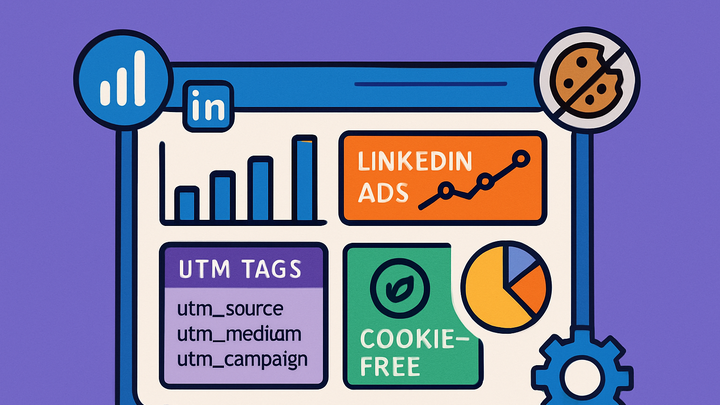Published on 2025-06-29T18:57:57Z
What is LinkedIn Ads? Examples and Tracking Best Practices
LinkedIn Ads is a paid advertising platform within LinkedIn’s professional network that enables businesses to target and engage a highly specific audience of professionals and decision-makers. It offers various ad formats—such as Sponsored Content, Sponsored Messaging, Text Ads, and Dynamic Ads—designed to meet different marketing objectives like brand awareness, lead generation, and event promotion. In the campaign tracking and analytics context, LinkedIn Ads URLs can be tagged with UTM parameters created via tools like UTM Guru to standardize attribution across multiple channels. For privacy-first and cookie-free data collection, analytics solutions such as Plainsignal capture clicks and pageviews without relying on third-party cookies. By combining LinkedIn Ads with precise UTM tagging and cookie-free analytics, marketers gain a comprehensive view of campaign performance, optimize ad spend, and improve conversion rates. This article dives into setup, integration, analysis, and best practices for effectively tracking your LinkedIn Ads campaigns.
Linkedin ads
LinkedIn Ads is LinkedIn's B2B advertising platform; learn tagging, Plainsignal integration, analytics, and best practices.
Overview of LinkedIn Ads
This section introduces LinkedIn Ads, its core features, and the ad formats available to marketers targeting professionals on LinkedIn.
-
Definition and purpose
LinkedIn Ads is a paid advertising platform within LinkedIn’s network designed to help businesses reach a professional audience for brand awareness, lead generation, and engagement.
-
Key ad formats
LinkedIn Ads offers multiple ad formats to suit different objectives.
- Sponsored content:
Native ads that appear directly in the LinkedIn feed to drive engagement and traffic.
- Sponsored messaging:
Personalized messages delivered to LinkedIn inboxes via Message Ads or Conversation Ads.
- Text ads:
Pay-per-click (PPC) ads displayed on the sidebar for cost-effective clicks.
- Dynamic ads:
Automated, personalized ads that adapt creative elements based on profile data.
- Sponsored content:
Setting Up Campaign Tracking
Guidance on how to implement tracking for LinkedIn Ads campaigns using UTM parameters and integrate cookie-free analytics solutions.
-
Configuring utm parameters
Use UTM parameters to tag LinkedIn Ads URLs for consistent attribution across analytics platforms. Tools like UTM Guru simplify building and managing UTMs.
- Utm_source:
Set to linkedin to identify the platform.
- Utm_medium:
Use cpc or paid_social to denote paid traffic.
- Utm_campaign:
Assign a descriptive name for your campaign (e.g., summer_sale).
- Custom parameters:
Optionally add utm_term and utm_content for deeper segmentation.
- Utm_source:
-
Integrating plainsignal for cookie-free analytics
Add PlainSignal’s script to your site to capture clicks and pageviews without cookies, ensuring privacy compliance.
- Implementation code:
Insert the following snippet in your HTML
<head>section:<link rel="preconnect" href="//eu.plainsignal.com/" crossorigin /> <script defer data-do="yourwebsitedomain.com" data-id="0GQV1xmtzQQ" data-api="//eu.plainsignal.com" src="//cdn.plainsignal.com/plainsignal-min.js"></script>
- Implementation code:
Analyzing Performance
How to measure and interpret the performance of LinkedIn Ads campaigns using key metrics and PlainSignal analytics.
-
Key metrics to monitor
Track metrics to assess effectiveness and ROI of LinkedIn Ads.
- Click-through rate (ctr):
Percentage of ad clicks divided by impressions; indicates ad relevance.
- Conversion rate:
Percentage of clicks leading to desired actions, like sign-ups or downloads.
- Cost per lead (cpl):
Total spend divided by the number of leads generated; measures efficiency.
- Engagement rate:
Interactions (likes, comments, shares) divided by impressions; shows content resonance.
- Click-through rate (ctr):
-
Creating reports in plainsignal
Use PlainSignal’s dashboard to build real-time reports that combine LinkedIn Ads data and UTM-tagged traffic for a unified view.
- Real-time dashboard:
Monitor live performance metrics without blocking cookies.
- Custom report builder:
Filter and segment data by campaign, source, or custom UTM dimensions.
- Real-time dashboard:
Best Practices and Tips
Recommendations to optimize tracking consistency, campaign performance, and data quality.
-
Maintain consistent naming conventions
Use a standardized naming scheme for UTM parameters to avoid fragmentation and ensure accurate reporting.
-
Regularly audit utm campaigns
Review and update UTM configurations in UTM Guru to fix errors and remove duplicates.
-
Perform a/b testing
Test ad creative, copy, and landing pages systematically to identify high-performing variations.
